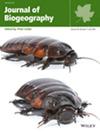Biogeographical Origins of Caatinga Squamata Fauna
Abstract
Aim
Several lines of evidence have noted that open vegetation biomes in the Neotropics are younger than moist forests, leading us to question which historical processes shaped the current species distribution patterns in these new biome formations. Here we investigate the temporal patterns of speciation and colonisation from surrounding biomes (Amazonia, Atlantic Forest and Cerrado) in the Caatinga historical assembly of squamate species, to understand the role of geomorphological events and climate change in driving its diversification.
Location
Neotropics.
Taxon
Squamata (snakes, lizards and amphisbaenians).
Methods
We used a phylogenetic tree and occurrence data for 459 squamate species distributed throughout four different biomes (Amazonia, Atlantic Forest, Cerrado and Caatinga) to reconstruct ancestral geographic ranges using the R package BioGeoBEARS. We used BAMM to estimate the rates of species diversification.
Results
Our results indicate that the current diversity patterns of squamates in the Caatinga were a result of pervasive faunal exchanges from adjacent biomes since the Paleogene, with similar numbers of dispersal events in each source area. The Neogene period was determinant in the diversification process, leading to the current assembly patterns of this group in the Caatinga.
Main Conclusions
The landscape transformation and climate change that increased aridity in northeastern Brazil probably shaped the diversification of dry-adapted squamates in the Caatinga, like tropidurid lizards. However, the Pleistocene climatic fluctuations associated with the highly heterogeneous gradients of topography, geology, soils, climatic conditions, and different vegetation physiognomies could have facilitated faunal exchange with their neighbouring forested biomes, explaining the current presence of some typical forested lineages inside the Caatinga domain and help us to clarify the current distribution patterns of squamates in this region.

 求助内容:
求助内容: 应助结果提醒方式:
应助结果提醒方式:


